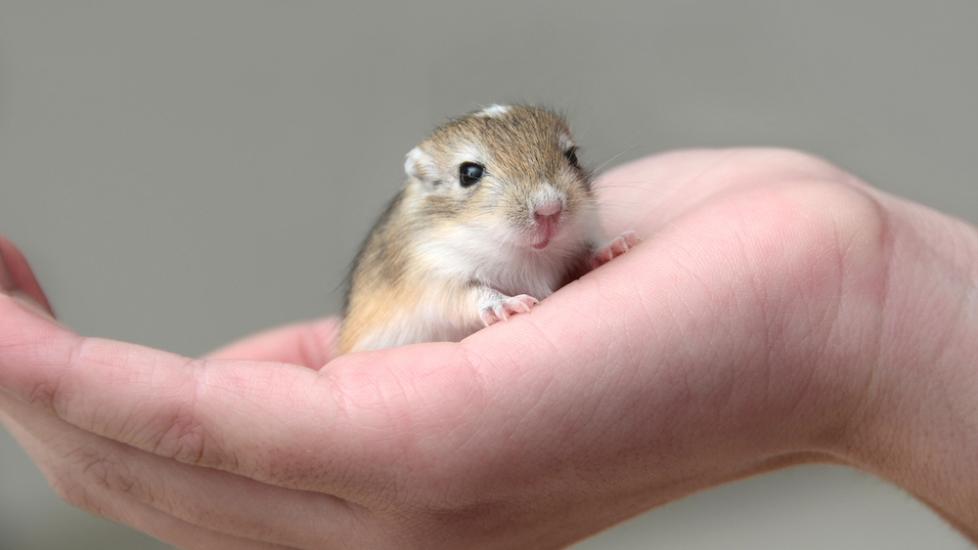Fractures in Gerbils
What Are Fractures in Gerbils?
Fractures of the legs are very common in gerbils. They usually occur as a result from injuries sustained on exercise wheels or cages with the wrong size mesh or from mishandling or falls. Fractures encompass partial or complete breaks in a bone.
Fractures of the tail also commonly happen when the tail is used to lift the pet. Gerbils are very social animals who can be trained to be held, but this should be done on the floor or over a soft surface. It’s important to remember to never pick your gerbil up by their tail. Damage to any bone can happen when gerbils are dropped on a hard surface. The most common fractures in gerbils involve the tail, the toes, and the legs.
Symptoms of Fractures in Gerbils
Signs of fracture in gerbils include:
-
Not using the limb or tail
-
Dragging the limb or tail
-
Swelling in any part of the body
-
Visible bending or bone from a limb
-
Hiding
-
Lack of appetite
-
Unwillingness to move from a nest
What To Do If Your Gerbil Breaks a Bone
Move your gerbil to a safe location and contact your veterinarian or small animal trained emergency vet.
Due to their small size, the best treatment for an injured gerbil is enclosure in a small travel cage with no mesh or toys to get tangled in, clean bedding, and a hide box.
How Veterinarians Treat Fractures in Gerbils
Treatment options for gerbils are limited due to their size. Whenever possible (partial fractures, minimal movement of the bone fragments), treatment will involve pain medication and bandaging. For more complicated fractures, sedation/anesthesia, X-rays, and/or surgery for fixation or amputation may be recommended.
Pain medication and antibiotics will be sent home on a case-by-case basis. Your veterinarian will recommend an Elizabethan collar or recovery cone to prevent the gerbil from chewing at the painful areas as they heal.
Costs for these treatments will vary based on where you live and the skill level of your veterinarian.
Recovery and Management of Fractures in Gerbils
Bone healing varies from four to 12 weeks, depending on the severity of the fracture, the ability of your veterinarian to stabilize the bone fragments, and the activity level of your gerbil. Medication should be given as directed, and your gerbil’s appetite should
be monitored carefully.
While healing, gerbils should be housed in a plain low container with fresh bedding, no mesh, wheels, or toys to get tangled in, and kept as clean as possible to discourage infection.
E. collars should be kept in place until veterinary approval is given for removal. Handling should be limited to gentle petting—no lifting or carrying until fully healed. All handling of gerbils by children should be supervised, and only solid-bottom exercise wheels should be used in the cage.
If you have bonded gerbils, they can be allowed supervised time together, as long as no one is chewing on bandages. If possible, keep the cages next to one another, to help lower anxiety in all animals.
Your veterinarian will discuss diet and environment as part of the recovery process and may recommend supplements such as calcium to aid in healing.
Fractures in Gerbil FAQs
Can a gerbil survive a broken leg?
Yes, gerbils can survive a broken leg. However, in some cases the leg must be amputated for your gerbil to return to health.
What to do if your gerbil is limping?
If you notice your gerbil limping, please schedule an appointment with a veterinarian versed in working with small mammal patients.
Can a gerbil live with a broken leg?
While an animal can live with a broken leg, there is a high risk of infection. As gerbils are prey animals, they are very susceptible to pain and can die by starvation if left untreated.
How long can a broken bone go untreated in gerbils?
The longer a fracture goes untreated, the more likely the limb will need to be amputated or the gerbil will get an infection and die. Preferably, your gerbil should be seen by a veterinarian in less than 24 hours.
Featured Image: iStock.com/sbossert
